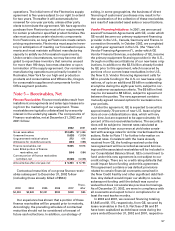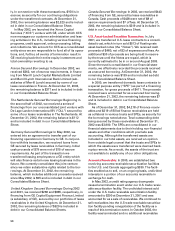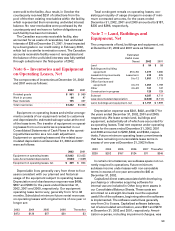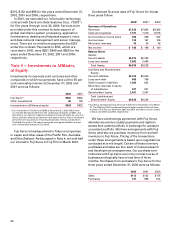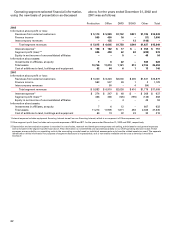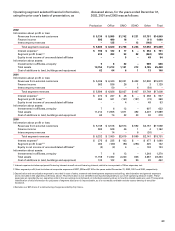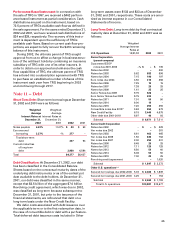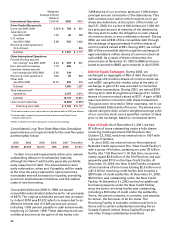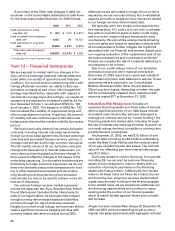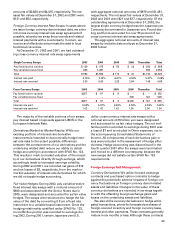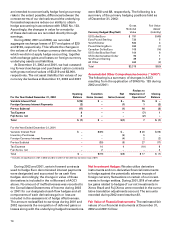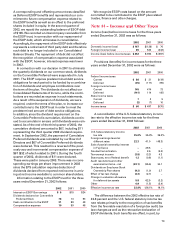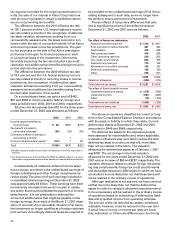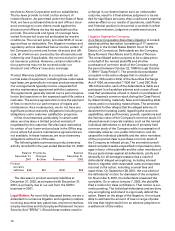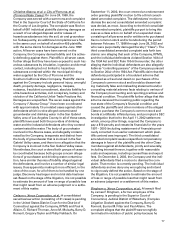Xerox 2002 Annual Report Download - page 69
Download and view the complete annual report
Please find page 69 of the 2002 Xerox annual report below. You can navigate through the pages in the report by either clicking on the pages listed below, or by using the keyword search tool below to find specific information within the annual report.
67
We could be required to repay portions of the loans
earlier than their scheduled maturities with specified
percentages of any proceeds we receive from capital
market debt issuances, equity issuances or asset sales
during the term of the New Credit Facility, except that
the revolving loan commitment cannot be reduced
below $1 billion as a result of such prepayments.
Additionally, all loans under the New Credit Facility
become due and payable upon the occurrence of a
change in control.
The New Credit Facility loans bear interest at LIBOR
plus 4.50 percent, except that a $500 term-loan tranche
bears interest at LIBOR plus a spread that varies
between 4.00 percent and 4.50 percent, depending on
the amount secured.
In connection with the New Credit Facility we
incurred fees and other expenses of $120 which have
been capitalized and are being amortized over its term
on a basis consistent with the scheduled repayments
in relation to the total amount of the loan facility.
Subject to certain limits, all obligations under the
New Credit Facility are currently secured by liens on
substantially all domestic assets of Xerox Corporation
and substantially all our U.S. subsidiaries (other than
Xerox Credit Corporation) and are guaranteed by sub-
stantially all our U.S. subsidiaries. In addition, revolv-
ing loans outstanding from time to time to Xerox
Capital (Europe) plc (XCE) (none at December 31,
2002) are also secured by all XCE’s assets and are
guaranteed on an unsecured basis by certain foreign
subsidiaries that directly or indirectly own all the out-
standing stock of XCE. Revolving loans outstanding
from time to time to Xerox Canada Capital Limited
(XCCL) ($50 at December 31, 2002) are secured by all
XCCL’s assets and are guaranteed on an unsecured
basis by our material Canadian subsidiaries, as
defined.
The New Credit Facility contains affirmative and
negative covenants which are more fully discussed in
Note 1.
At December 31, 2002, we are in compliance with
all aspects of the New Credit Facility including finan-
cial covenants and expect to be in compliance for at
least the next twelve months. Failure to be in compli-
ance with any material provision or covenant of the
New Credit Facility could have a material adverse
effect on our liquidity and operations.
We are required to make scheduled amortization
payments of $202.5 on each of March 31, 2003 and
September 30, 2003, and $302.5 on each of March 31,
2004 and September 30, 2004. In addition, mandatory
prepayments are required from a portion of any pro-
ceeds we receive from certain asset transfers or debt
or equity issuances, as those terms are defined in the
New Credit Facility. Any such prepayments would be
credited toward the scheduled amortization payments
in direct order of maturity.
Senior Notes: In January 2002, we completed an
unregistered offering in the U.S. ($600) and Europe
(225) of 9.75 percent senior notes due in 2009
(“Senior Notes”) and received net cash proceeds of
$746, which included $559 and 209. The senior notes
were issued at a 4.833 percent discount and pay inter-
est semiannually on January 15 and July 15. In March
2002, we filed a registration statement to exchange
senior registered notes for these unregistered senior
notes. This registration statement has not yet been
declared effective. The terms of the debt include
increases in the interest rate to the extent the registra-
tion is delayed. Such increases will be up to 0.50 per-
cent and will be effective until the registration
effectiveness is complete. As of January 17, 2003, the
interest rate increased to 10.0 percent. Fees of $16
incurred in connection with this offering have been
capitalized as debt issue costs and are being
amortized over the term of the notes. These Senior
Notes are guaranteed by certain of our U.S.
subsidiaries and contain several affirmative and nega-
tive covenants similar to those in the New Credit
Facility, but taken as a whole are less restrictive than
those in the New Credit Facility. We were in compli-
ance with these covenants at December 31, 2002.
Guarantees: At December 31, 2002, we have guaran-
teed $1.9 billion of indebtedness of our foreign
wholly-owned subsidiaries. This debt is included in
our Consolidated Balance Sheet as of such date.
Interest: Interest paid by us on our short- and long-
term debt amounted to $772, $1,074, and $1,050 for
the years ended December 31, 2002, 2001 and 2000,
respectively.
Interest expense and interest income consisted of:
Year Ended December 31, 2002 2001 2000
Interest expense(1) $ 751 $ 937 $ 1,090
Interest income(2) (1,077) (1,230) (1,239)
1 Includes Equipment financing interest, as well as non-financing interest
expense that is included in Other expenses, net in the Consolidated
Statements of Income.
2 Includes Finance income, as well as other interest income that is included in
Other expenses, net in the Consolidated Statements of Income.
Equipment financing interest is determined based
on a combination of actual interest expense incurred
on financing debt, as well as our estimated cost of
funds, applied against the estimated level of debt
required to support our financed receivables. The
estimate is based on an assumed ratio of debt as com-
pared to our finance receivables. This ratio ranges
from 80-90 percent of our average finance receivables.
This methodology has been consistently applied for
all periods presented.


